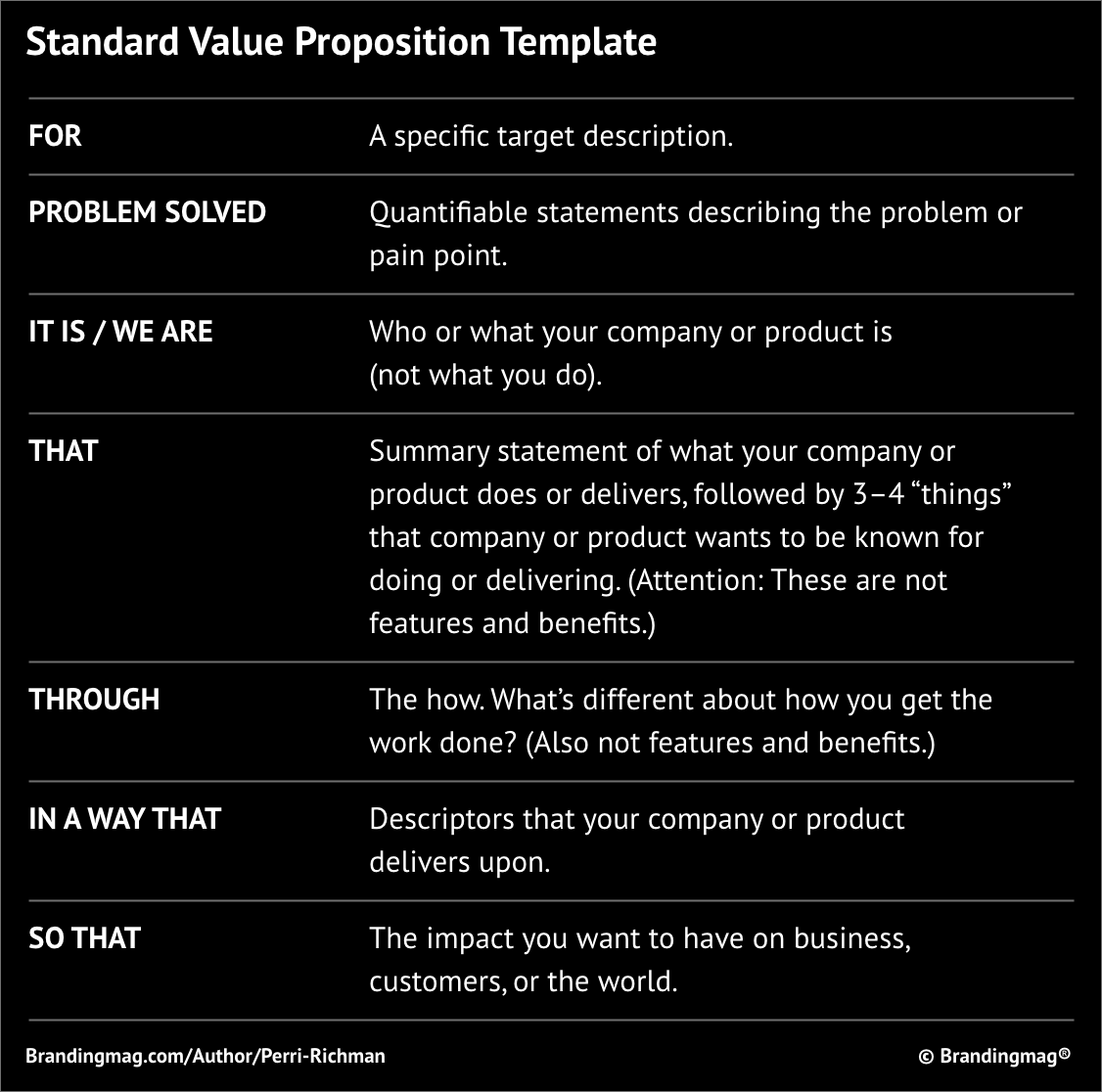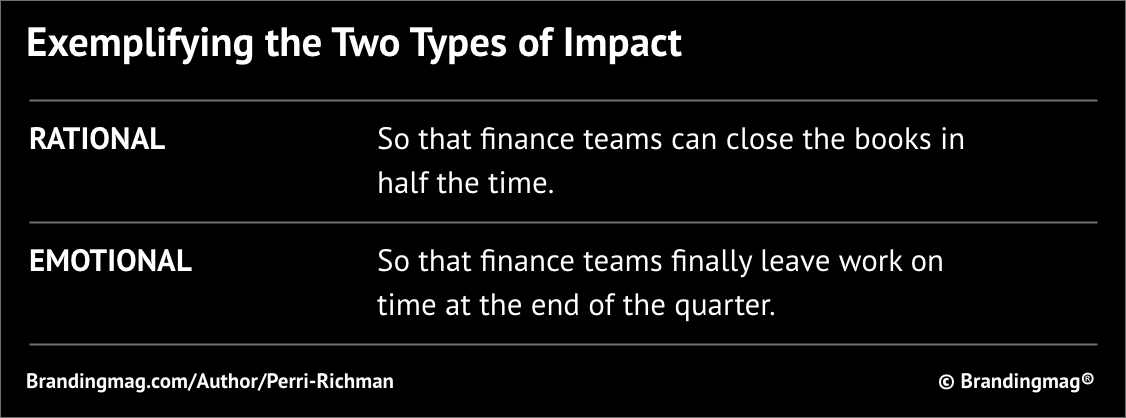
Value propositions are vital for communicating how a business-to-business (B2B) company, product, or service adds value to customers and other stakeholders. They are central to brand building because they align what your company or product offers with what your customers truly need, driving clarity, confidence, and conversion.
According to the Academy of Marketing Science, although marketers and academics use the term “value proposition”, the model is neither well understood nor well implemented. Most value propositions today are full of “blah blah blah”. They’re often tossed into decks without depth or specificity to guide real decisions.
While the term “value proposition” sounds strategic, it’s rarely backed by a clear, actionable message—and in many cases, it’s missing the “how”. B2B marketers often focus on features, benefits, and cost (which are all worthwhile attributes), or they tie products or companies to aspirational intents like:
- Save time and money
- Improve satisfaction
- Reduce risk
- Handle tough conditions
How many times have brand marketers said, “Our brand is about providing customer peace of mind?” Features, benefits, return on investment (ROI), and big claims hold up until a buyer asks for evidence. What’s missing is simplicity and specificity. It’s time to reframe them as assets that make marketing more productive and drive customer conversion.
Value propositions are really value quantifications
A true value proposition isn’t just a brand promise, it’s proof. Buyers don’t want vague claims or platitudes. They want to know—in plain language—what they’re getting, why it matters, and how it directly solves their problem. That means quantifying impact, not just describing intent.
Don’t worry, brand marketers, the clever language that elevates a brand and makes it memorable comes later in the game. However, without the nuts and bolts of a well-constructed value proposition, you’re branding a marshmallow.
Here’s a standard value proposition template.
Now, let’s dig into each section.
Get granular with targets
As brand marketers, you can’t afford to market to everyone—and you shouldn’t try. The more precisely you define your target audience, the more focused and effective your messaging, outreach, and impact will be.
There’s a common misnomer that being too specific means missing opportunities. In reality, the opposite is true. When you’re specific in your target, you can design brand messages that resonate. Buyers will see themselves in your story and be attracted to your brand. Two examples:
- Tire dealers and repair shops that value rugged, reliable equipment that makes tough tasks and manual processes faster and easier.
- Medium- to high-volume tire dealers and repair shops (500 cars per month with 4+ bay count) who have waited 7-10 years since buying technology for passenger vehicles seeking to…
One really good filter is to see if you can make an objective list of prospects to target based upon your criteria. If you can do this easily, you’re being specific enough; otherwise, sharpen your pencil and get more focused.
Be specific in the problem you’re solving
Time, knowledge, efficiency, engagement, and bandwidth are common challenges. Many marketers promise answers, yet these challenges show up differently for every buyer. The problem you’re solving must be specific, relevant, and backed by proof. Here are three key questions to frame your problem statement:
- What is the buyer frustrated with?
- What workarounds do you use?
- What’s costing credibility, money, time?
To get specific, use these filters: Have you spoken with prospects and customers? How specifically can you articulate their pain points? And can you substantiate their problems with facts and details?
Let’s take a look at two problem statements for a marketing firm targeting chief marketing officers (CMOs). It’s clear which one is more specific:
- Marketers don’t have the bandwidth to manage teams, and agencies are concerned with their own credibility.
- The average tenure of a B2B CMO is 2 years (turnover is higher than other C-level roles). There’s pressure to deliver revenue, not leads or website visits. CMOs may not have all the technical skills, mature teams, or cash for multiple or large agencies. They’re looking for marketing firms that can help them:
- Stand out from the pack when “smart” or “AI-enabled”
- Personalize content for a wide variety of targets
- Keep up with emerging channels and marketing tech
- Assess whether efforts are working.
Don’t skip the “we are” or “it is”
Brand marketers often dive straight into what a company or product does, skipping over what it actually is. When we assume the buyer already knows, we lose opportunity. If they can’t answer “what type of company are you” or “what kind of product you offer”, then you’ve skipped over the nouns required to describe who you are or what your product is. Here are two examples:
- We increase animal health and performance from innovative, scientifically proven products based on decades of leadership.
- We are an integrated marketing communications firm focused solely on the B2B middle market. We specialize in industrial, biotech, and technology firms with $50-250M in revenue who need to mobilize marketing to achieve profitable growth targets.
The other issue that regularly arises is the overuse of adjectives. Every company and product claims to be leading, innovative, strategic, durable, or must-have. Without evidence, those words take up space and blur into background noise. Focus on who you or your product are in concrete terms backed by proof, not platitudes.
State what you or your product does
The “that” section captures what your company or product does, and what you want to be recognized for doing. It can reflect your current strengths or speak to your aspirational identity (i.e., the role you’re building toward in the market).
For company value propositions, skip the laundry list of what you do or what you offer. Your value proposition isn’t a service catalog, it’s a focused description of what you do best. Ask yourself: What do we deliver better than anyone else? And what credible performance claims can we make?
The first example below is a laundry list of what the company does. The second example outlines what the company does, along with the value it brings.
- We specialize in the research and development, production, sales and service of automotive advanced diagnostics, detection and analysis systems and automotive electronic components.
- We help building owners make decisions about building automation during new construction and modernization. Our work helps achieve operating goals, beginning with engineering and project planning and extending through the life of the system.
For product value propositions, do not list specs. Use words to show what your product or service does, how it works, and why it matters. Get specific about what sets it apart and what it enables for the customer. Provide clear, provable performance claims.
The first example below offers platitudes and buzzwords. The second example speaks to what’s different with justifiable claims.
- Our platform offers end-to-end workflow automation, AI-powered analytics, real-time dashboards, cloud-based access, and seamless integration with Salesforce and HubSpot.
- Direct drive proprietary technology delivers a superior balancing result—up to 10x faster than non-direct drive balancers, and the only technology on the market with a 10-year warranty on the motor.
Keep answering “how, how, and how?”
The “through” section is where real differentiation lives. It’s not just what you say, it’s how deeply you can back it up. Once you make a claim, don’t stop. Keep asking: How? How? How? Push until your statement becomes tangible and provable—that’s where credibility kicks in.
For company value propositions: It’s your approach, your background, and your belief system that make you different. Avoid cliches and focus specifically on how you solve problems differently. Everyone has deep industry experience, is highly strategic, engages teams, and makes the complex simple.
Also remember that evolution is part of the story. Don’t hide your company’s past—own it, build on it, and let it fuel your next chapter. The first example below is way too broad, while the second example humanizes the brand with a belief statement.
- Our business is expertise, bringing clients innovative strategies to make their businesses better, to make systems more valuable assets, and to satisfy every user who logs on.
- Every client engagement is backed by the belief that achieving high performance buildings begins with must-do elements like zoning, building codes, inspections, and approvals, and has the potential to achieve and exceed environmental and operating commitments by at least 20%.
For product value propositions: This isn’t just about features and benefits. It’s about what you uniquely offer—what no one else does and how no one else does it. Your differentiators might be service levels, engineering platforms, or approaches.
You can also draw from your brand’s core strengths. For example: “All products in the portfolio are designed to work as a system, come with proactive maintenance, and only require one call for service.” The key: Make it factual, make it provable, and make it matter.
The first example below is full of adjectives, while the second example provides the specificity needed to break through.
- Through our cutting-edge technology stack, modular design, and robust encryption framework, we empower enterprises to seamlessly manage data security across cloud environments.
- We help you prioritize 10-300 (average is 20) alarms; conduct the programming, engineering, and configuration; work with your IT department on Internet access and security; train your team on how to use; test and implement. Setup can be complete in as little as two weeks.
It’s time for adjectives
Think of “in a way that is” as the connective bridge between your company or product and why it matters. It explains how you deliver value, making your message more descriptive and compelling.
In this portion of the value proposition, you’re shaping how your company or product feels on its best day. Describe it vividly, honestly, and powerfully. List every adjective that captures your edge. Reach for adjectives that are earned and energizing—the kind that paint a real picture of what makes you different when you’re at your best.
Then, pressure test your adjectives by running them through the “how filter”. Let’s say you’ve described your product or company as “innovative”. Ask yourself, “How exactly are we innovative?” and “How does our product innovate in a way that matters to customers?” The how filter will help you uncover much more precise language—words that show real differentiation instead of vague labels.
Then, take it one step further. Turn adjectives into value statements. Translate your best descriptors into lines that communicate customer benefits. These can become brand statements, website headlines, collateral taglines, or even social hashtags.
Here’s the process in action: The first example below is a weak adjective resulting in a weak brand statement. The second is a strong adjective resulting in a game-changing brand statement.
- Adjective: Optimize
Brand statement: Spend more time optimizing performance. - Adjective: Empathetic
Brand statement: Modern public relations is empathetic marketing backed by hard metrics.
Give your value message meaning
The “so that” is where your message gains meaning. It communicates the impact your company or product aims to have on your audience, their goals, and even the broader world. It brings attention to why the value you offer matters, in both rational and emotional terms.
Your “so that” statement doesn’t have to start from scratch. Look at your brand positioning, purpose, or promise; they’re often full of rich, impact-driven language. Pull from those foundations to express the deeper why behind your company or product. It also helps keep your value proposition aligned to your brand.
What do you do now that your value proposition is complete?
Many B2B brand marketers complete their value propositions and then start from scratch developing web pages, collateral materials, or social media posts. When you’re developing collateral, web pages, social posts, or product messaging, do not start over. Your value proposition is your foundation. Pull it out of the template and use it.
Pull the value proposition language out of the template.
- Merge your “it is” or “we are” with “for” to get the core flow of your story.
- Then, refine. Trim the language. Add section headers.
- Use your previously crafted “in a way that” and “so that” lines as headlines or transitions. They help keep the narrative connected.
If you end up reshuffling content on a site or solution sheet, check back in with your original value proposition. If the story doesn’t align, it’s time to refine. Use it top to bottom in the order in which it’s outlined in the template.
It works every time.
Cover image source: ad_stock

